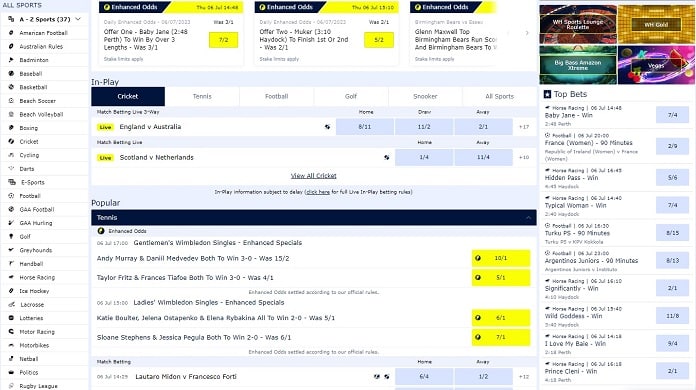How Do Betting Odds Work? – Different Types of Betting Odds Explained
For those of you pondering how do betting odds work in the UK, you’ve come to the right place. In this guide to one of the fundamental building blocks of gambling and basics to sports betting, our experts look at how prices are formed and can be expressed. Whether you prefer fractions, decimals or American-style odds formats, all that and more is explained in simple terms.
What are Betting Odds?

When you see a price next to a selection from the markets on online betting sites, those are the odds. They reflect the chances, i.e. likelihood, of that being the outcome. Part of understanding how do betting odds work is getting your head around implied probability. This is the percentage chance of a wager actually winning based on its price. No bet you place can be 100% absolutely certain, or have 0% likelihood, but any punts you take fall somewhere in-between those extremes.
Precisely where on the spectrum of implied probability your bet lies depends on the odds. The shorter the price offered by the bookies, then the more likely they think an outcome is. Implied probability, and betting odds by extension, aren’t always right. That is one of the things about gambling on sports with bookmakers.
How Do Betting Odds Work?
Now that you understand the basics, it’s time to look at how do odds work in betting markets. Although the prices offered by the bookies are called “fixed odds”, they’re anything but in fact. The term is misleading in that it suggests they don’t change. Betting odds drift, i.e. get bigger, and/or shorten, i.e. increase in likelihood, all the time.
This is largely down to external factors. There are a number of reasons why market gambles, called steamers in the industry jargon when they’re backed and shorten, develop. Respected betting tipsters may have recommended a particular bet to punters, who all follow that advice, or intended participants have had to withdraw increasing the chances of others.
Although bookmakers operate at an overround, a percentage profit margin built into the market over 100%, so they make money no matter which outcome wins, they do still have a responsibility to try and balance it somewhat. As one outcome comes in for support, other selections can have their betting odds pushed out to bigger prices to compensate for that.
In other words, if the implied probability of one thing increases, it naturally follows that others must decrease. While you can technically have more than one winner in some sports with the dead-head existing in greyhound betting and horse racing for example, ties cannot happen in others.
Either a football game is won in 90 minutes or finishes drawn. If there must be a winner on the day, then extra time and penalties can be used to decide that, but the market and betting odds only covers normal time. There are always going to be scenarios beyond the foreseeable and regulation scope of sport that bookmakers cannot legislate for.
What is Implied Probability?
To recap, implied probability is the percentage chance of a wager winning based on its price. This is a key part of figuring out how do betting odds work today. The term Evens in a gambling context means the likelihood of your bet coming off is 50%. Anything shorter than that, i.e. with a higher implied probability, is what they call odds-on. This means that no matter how much you stake on the wager, you cannot double your money.
If a bet is a bigger price than Evens, then it is said to be odds against. The implied probability is lower than 50%, then, but means you will more than double your money off any returns from a wager. There are different ways of calculating the percentage likelihood of your bet coming off, but that depends on the odds format used. More on that later, but the table below looks at common prices and their implied probability:
| Fractional Odds Price | Decimal Odds Price | Implied Probability |
| 1/9 | 1.11 | 90% |
| 1/4 | 1.25 | 80% |
| 1/3 | 1.33 | 75% |
| 1/2 | 1.50 | 66.7% |
| 4/6 | 1.67 | 60% |
| Evens | 2.00 | 50% |
| 6/4 | 2.50 | 40% |
| 2/1 | 3.00 | 33.3% |
| 3/1 | 4.00 | 25% |
| 4/1 | 5.00 | 20% |
| 9/1 | 10.00 | 10% |
How Are Betting Odds Calculated?
We’ve talked about how do betting odds work now, but what about calculating them? Traders employed by bookmakers come up with the prices they offer. Don’t think that their fixed odds are plucked out of thin air, however, as a lot of data goes into algorithms and models to arrive at them.
Traders consider past form and meetings between participants in a sport, as well as suspensions, injuries and fitness, and the conditions and location of the event. They will also use betting exchanges like Betfair as a guide, where professional punters both back outcomes to win and lay them not to happen.
Different Types of Odds
As noted earlier in our discussion, you can see the prices displayed on sports betting sites in different odds formats. Each has its uses, but they all amount to the same thing. It’s about picking a way of expressing prices and style of betting odds that you’re comfortable with. Whether you prefer traditional British fractional odds, the European model and decimal odds, or even moneyline American odds, all three options should be open to you. Let’s look at each different type of odds in turn:
How Do Fractional Odds Work in Betting?
When most British people ask how do betting odds work in the UK, seeing the prices as fractions is the format they’re talking about. Dating back to the days when only on-course board prices for horse racing betting at an actual meeting were available, fractional odds were based on wagers struck in the pre-decimalised currency of half-crowns.
As horses were backed by punters and others drifting to balance the market along the rails of the betting ring, individual bookmakers would physically rub out the price on their chalkboards when it had gone and wrote up the new odds in their place as they changed. This evokes a certain romanticism, but the last vestige of this bygone era is expressing a bet in fractions.
There’s a simple way to understand them too. When asked how do fractional odds work in betting terms, consider the numerator and denominator as a guide. The number above the dividing line is what you could win based on a stake that corresponds to the number below it. In other words, fractional odds show you what you could win in a ratio based on the numerator and denominator.
Let’s work through an example. If you bet on a horse at fractional odds of 15/8, an £8 stake creates £15 of potential profit. You must remember to add your stake on to the winnings, however, if you want to calculate total returns. You would receive £23 back on your successful £8 wager at that price.
How Do Decimal Betting Odds Work?
Best known in continental Europe, prices expressed as decimal numbers are becoming more popular in the British Isles. They’re seen as more modern than their fractional counterparts and have a different focus. Whereas fractions highlight the ratio of stake to profit, decimal betting odds concern themselves with the overall return of a wager.
Whilst it’s easy to see with fractional prices when a bet is odds-on as it becomes top-heavy with the numerator bigger than the denominator, decimals work differently. The key threshold is 2.00. This is the decimal equivalent of Evens. Any number smaller than it is odds-on, whilst larger ones are odds against.
When asked how do decimal betting odds work then, the answer is to multiply your stake by the price offered. This shows you total returns. If you bet £20 on a football team winning and both teams to score at 3.25, then you receive £65 back from the bookies if the wager is successful.
Calculating profit on this is then just a matter of subtracting your stake from the total returns. A simple sum of £65 minus £20 leaves us with £45, the difference between what was wagered and the amount that came back from the bookies. There’s £45 of profit in this bet.
How Do American Betting Odds Work?
If you’ve heard of the phrase moneyline bet in connection with gambling, then those are the American format for odds. The outcomes in the market are expressed as whole numbers with either a plus or minus sign in front of them. Any negative number next to a wager denotes that it’s odds-on. You must stake whatever this number is in order to win $100.
With positive numbers, the answer to how do American betting odds work is they show you what you win from a $100 wager. If, for example, you back the underdogs on the moneyline in the NFL betting on a game at +175, then a $100 bet returns $275 in total with $175 of that being profit.
Should you side with the favourites in the American football match instead at -125, you need to wager $125 to turn a $100 profit. The total returns here are $225. This US-system of expressing betting odds is largely confined to sports popular across the Atlantic, which also include basketball, baseball and ice hockey and their respective major leagues.
How to Read Betting Odds
A key element of understanding how do betting odds work is an ability to read them correctly. Depending on your preferred format from the three discussed above, each works differently. To recap, fractional odds are all about the ratio of stakes to profits, decimal odds show you total returns and American odds take $100 as either the unit stake or desired profit based on the price. Converting one format to another is a skill you develop over time.
How Do You Work Out Betting Odds & Convert Them?
Taking our above table and adding American odds in there should help you with any conversion of prices needed. Remember, any odds-on bet expressed as a fractional or decimal is a negative number using the moneyline odds format. If you’re converting between fractions and decimals, then always remember to divide the numerator by the denominator and then add one, which represents the stake. Conversely, you’ll need to subtract one from decimal odds to help with converting back into fractions.
| Fractional Odds Price | Decimal Odds Price | American Odds Price | Implied Probability |
| 1/9 | 1.11 | -900 | 90% |
| 1/4 | 1.25 | -400 | 80% |
| 1/3 | 1.33 | -300 | 75% |
| 1/2 | 1.50 | -200 | 66.7% |
| 4/6 | 1.67 | -150 | 60% |
| Evens | 2.00 | +100 | 50% |
| 6/4 | 2.50 | +150 | 40% |
| 2/1 | 3.00 | +200 | 33.3% |
| 3/1 | 4.00 | +300 | 25% |
| 4/1 | 5.00 | +400 | 20% |
| 9/1 | 10.00 | +900 | 10% |
How Do Sports Betting Odds Work?
British punters enjoy wagering on two sports in particular. Proof, as if it were needed, can be found in the UK Gambling Commission betting industry statistics published in November 2022, which shows in the surveyed period over three-quarters (78%) of the £2.4 billion Gross Gambling Yield for remote betting came from football (£1.1 billion, 46%) and horse racing (£768.5 million, 32%). It’s worth looking at these beloved betting pastimes in more detail, then.
How Do Betting Odds Work in Football?
The above stats show that betting on football is number one when it comes to sports wagers placed in the UK today. Brits love the beautiful game and taking a price about the teams they fancy. It’s not too difficult having football betting odds explained if you’re new to it all, though. The main 1X2 or full-time match result market is simple. You can wager on either team to win the game (in 90 minutes) or for it to end in a draw.
With so many matches taking place on a Saturday, this has given rise to football accumulator betting where punters combine several selections from different games. The odds multiply from leg to leg as a result. Accumulators, called accas for short, are tougher to pull off as you need multiple results and outcomes to go your way.
An increased popularity in Premier League betting reflects its growth and status as a competition with distribution and TV rights now worth billions. It’s a product that everyone wants to tune into worldwide with many of the best footballer playing for top English clubs. Away from betting on the latest matches, you can have wagers that last the length of the entire football season in outright markets like league winner, top 4/6/10 finishes, top goalscorer and relegation.
How Do Horse Betting Odds Work?
Thanks to an inextricable link with gambling that no other sport compares too, horse racing has been responsible for so many innovations in betting. Without it, the each way bet would not exist, where you can back a horse both to win its race and finished placed at the same time. The short answer to how do betting odds work in horse racing is it’s more complicated than football.
There are more potential outcomes to horse races than a game, and that’s factored into the prices on offer. You can also wager on specific horse racing events ahead of time thanks to ante post betting markets available through the bookies. This often helps you get a better price before the final field of runners is known, but there are also risks attached.
You aren’t guaranteed a run for your money, for instance, and can’t take advantage of Best Odds Guaranteed terms that are offered after declarations. This promotion gives you the Starting Price (SP) if it’s bigger than the horse racing odds you took earlier that day. Deciding what to bet on and when is part of the fine judgments relating to thoroughbred racehorses you must make when gambling.
Non-runners can also impact any wagers you make. If a horse is withdrawn at odds of 14/1 or less, then a Rule 4 deduction as enshrined in Tattersalls Rules on Betting applies based on 5p intervals for every £1 staked. That’s not ideal but understanding this is part and parcel of having horse racing betting odds explained to you. Absentees after final declarations can also lead to revised place terms on an each way bet, with industry standard practice laid out on this.







